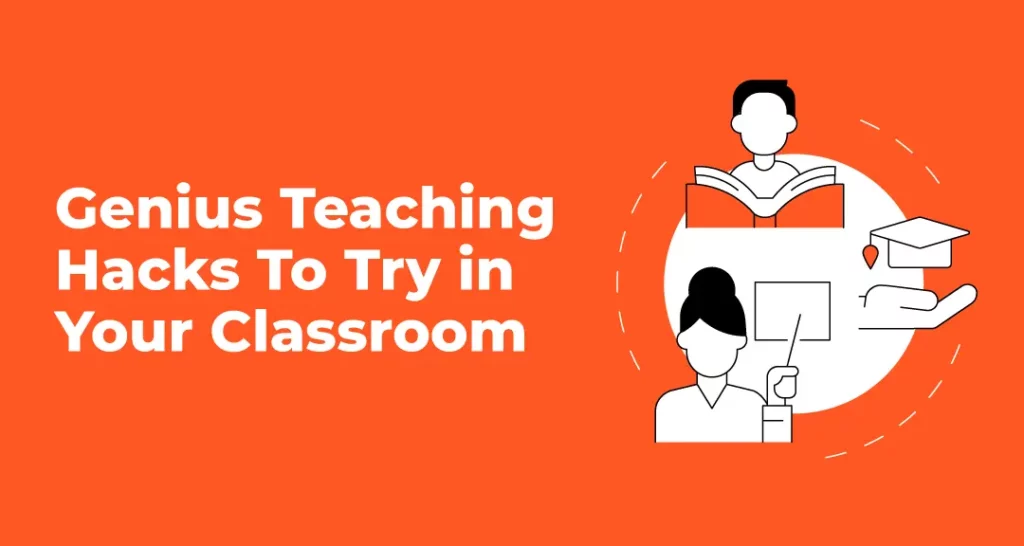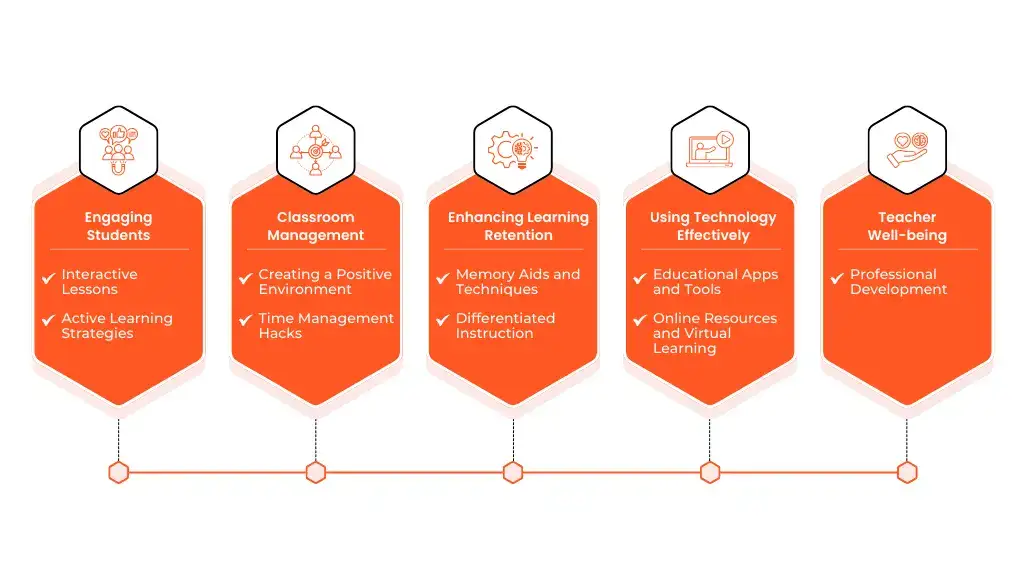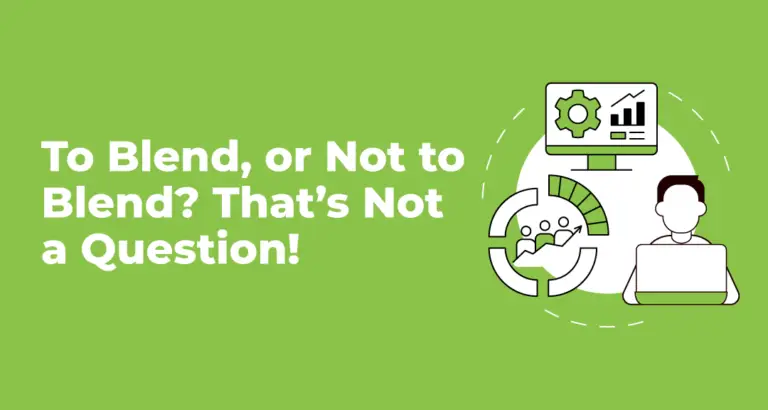Genius Teaching Hacks for Your Classroom
- Teaching
- July 20, 2024
- Viva VOLT

Picture a classroom where joy, laughter and learning are intertwined. Should it not be a room where each child can lean forward eagerly to listen and discover? Should it not be the place where creativity and knowledge are allowed to flow freely?
Gone are the days when a teacher used to enter the classroom to write on the board and continue teaching the blank-faced students. We have come a long way since those days of passive listening and rot learning. Today, we live in a completely different era of rapid technological advancements, when a classroom is galvanized into action by a broad gamut of gamified and active learning experiences. Thus, capturing students’ attention through a set of cut-and-dried instructions is as improbable as catching light in a bottle.
To survive and thrive in a classroom getting increasingly exposed to a high-paced learning revolution, teachers need to acknowledge that traditional monologue-style teaching practices are well on way to losing their relevance. Now, given the fact that a child’s attention span could be as short as three minutes, it is high time for teachers to take centre stage and engage in intellectual learning experiences using a powerful secret weapon—a toolkit of genius teaching tricks.
Through interactive learning-powered teaching hacks and lesson planning, the students feel motivated and participate actively. This is attested by the fact that 91% of learners value fun in learning. Let’s see how it happens.
Benefits of Active Learning

1. Increase in Classroom Engagement: Fun teaching tricks enable the instructors to gain students’ attention and keep them involved in classroom activities. Adequacy of inclusive learning space inside prompts active, outcome-driven participation.
2. Enhanced Motivation: Incorporating playful teaching practices will instantly boost students’ intrinsic motivation and curiosity. In a holistic learning environment, students feel positive, accepted, secure, comfortable, happy and motivated to explore more. To make the environment more encouraging, teachers are advised to invest time in lesson planning, and schedule activities like interactive games, hands-on projects, role-playing, brainstorming sessions, and group discussions with their planners.
3. Improved Retention: Fun and interactive activities always encourage better student participation, resulting in fewer empty seats with blank faces. In comparison to the conventional practice of passive learning, today’s teaching practices propelled by interactive activities help students gain a better understanding of the topic and memorize information for a longer time.
4. Cultivating Creativity: Fun teaching has a greater role in fostering creativity and confidence among students by creating an encouraging environment. Active learning makes students feel comfortable to explore, express ideas, take risks, and think outside the box. When teachers implement genius teaching hacks in the classroom, learning becomes enjoyable, with teachers stimulating students’ imagination and helping them channelize their potential to develop divergent thinking skills.
5. Reduced Stress and Anxiety: When students experience a fun-filled, collaborative and positively charged classroom atmosphere, they overcome the fear of failure, which in turn reduces stress and anxiety. Interestingly, fun teaching practices strongly rest on one basic rule—mistakes are stepping stones to fruitful learning, not failures.
Indeed, adding some playfulness to the set of activities created for the classroom allows teachers to foster knowledge retention and skill development. But how can we add playfulness? What is the right way to do it? Are there any proven guidelines available for teachers? Well, yes! Teachers can turn a boring classroom experience into a thrilling learning atmosphere by using various genius teaching hacks that have proved to be effective over time.
Best Teaching Hacks Explained Here

Section 1: Engaging Students
A) Interactive Lessons
• Use of Technology: Introducing digitally-driven technological innovations in learning redefines the dynamics of traditional teaching and encourages self-paced collaborative learning faster. Capitalizing on smartboards and tablets not only elevates interactivity level inside the classroom, but brings life to teaching by making complex topics simple, easy-to-understand, and engaging for students.
• Game-like Lessons: When you introduce game-like elements into your lesson, it makes teaching interesting and engaging. To improve participation in learning activities through competition, we should consider implementing Reward systems, leaderboards, and game-based activities.
• Use of Multimedia: The use of multimedia resources for teaching in an educational setting can accommodate auditory learners while podcasts are visual in nature. Traditional teaching tends to become monotonous, but multimedia tools can break this monotony, thus giving a variety of perspectives about the topic at hand. At VOLT, teachers get instant access to comprehensive interactive contents (such as chapter videos, smart interactive activities, assessment, and worksheets) curated mindfully for a playful experience of classroom learning.
B) Active Learning Strategies
• Think-Pair-Share: This teamwork technique requires students to think first as individuals and then discuss with partners before sharing with the class as a whole. It supports critical thinking and communication skills.
• Group Projects and Collaborative Learning: Working in groups encourages cohesion among students as they also get to learn from each other. Working in environments of group work-based learning enables the learners to develop social skills with diverse points of view.
• Hands-On Activities and Experiments: Practical activities and experiments enable students to apply theoretical knowledge in real-world scenarios. This experiential learning approach enhances understanding and retention.
Section 2: Classroom Management
A) Creating a Positive Environment
• Establishing Clear Expectations and Rules: Clearly stated expectations and regulations are instrumental in establishing an ordered and respectful classroom environment. Students can comprehend borders and expectancies while adhering to the rules laid down for this purpose.
• Rewards and Positive Reinforcement System: Encouraging positive conduct goes a long way in motivating students to maintain high standards. Some reward systems may include certificates, praises or small incentives that will help learners develop good behaviours and academic scores.
• Dispute Resolution Methods: Teaching students how to resolve disputes helps keep the environment peaceful. Mediation and peer counselling can be effective ways to resolve conflicts while promoting respect within a group.
B) Time Management Hacks
• Efficient Transition Strategies: Quick transitions can take less time and allow for more concentration of students. There are various techniques like countdowns, signals and clear instructions that ensure smooth switching between activities.
• Time Management Tools and Apps: Teachers may employ time management tools in order to remain organized concerning their daily routines. Digital planners, for example, simplify planning as well as the process of execution across task management apps.
Section 3: Enhancing Learning Retention
A) Memory Aids and Techniques
• Mnemonics and Acronyms: Memory aids such as mnemonics and acronyms can be used to simplify complex information, making it easier to remember. In particular, these memory aids come in handy for those subjects that need memorization.
• Visual Aids and Mind Maps: Students can make use of visual aids like charts, diagrams and mind maps, thus enabling them to visualize the connections between ideas. Such tools help turn abstract thoughts into practical examples that are more memorable.
• Spaced Repetition and Retrieval Practice: Spaced repetition is about reviewing the material at increasing intervals to improve long-term retention. Retrieval practice or self-quizzing strengthens recall by challenging students’ recollection ability.
B) Differentiated Instruction
• Tailoring Lessons to Different Learning Styles: Teachers who recognize that their students have different learning styles can modify their teaching methods accordingly, accommodating the visual, auditory, kinesthetic, or reading/writing preferences of their students so that every student has a fair chance.
• Providing Choices in Assignments: Engaging students through assignments with options can go a long way in motivating them. Moreover, when learners are allowed to choose topics or formats they find appealing, this makes learning more personal and, hence, fun.
• Utilizing Personalized Learning Plans: Such plans tailor learning experiences to fit each student’s unique needs and aspirations. The instructor should be able to determine the post-secondary goals as well as the current level of performance for each child.
Section 4: Using Technology Effectively
A) Educational Apps and Tools
• Smart Online Learning Solutions: Today’s technology-driven era belongs to the outcome-oriented learning experience. To achieve this, teachers can embrace smart online learning solutions empowering students with tailor-made content for uninterrupted immersive learning. At ViVA VOLT, we help teachers transform their traditional teaching-learning processes inside the classroom through digital teaching-learning resources that can be accessed conveniently from here.
• Tools for Creating Interactive Content: Teachers can always take the help of interactive tools like Nearpod, Edpuzzle, and Canva to develop graphically rich engaging lessons that are rich in media content and make lessons more interesting.
B) Online Resources and Virtual Learning
• Best Websites for Educational Content: There are many options, but Khan Academy, Viva VOLT, TED-Ed, and Coursera are best choices to get high-quality educational content. On these platforms, teachers can experience the ease of learning anywhere and everywhere. Also, websites like Viva VOLT offer high-quality teaching resources and VOLT English Central access crafted first-hand by top industry experts.
• Virtual Field Trips: Students’ active participation in virtual field trips such as museums, historical centers, and beautiful natural attractions brings students real-life experiences that go beyond the classroom environment.
Section 5: Teacher Well-being
A) Professional Development
• Scaling-Up Knowledge Through Online Courses and Webinars: Online courses and webinars offer opportunities for continuous learning and skill development. Platforms like Coursera, EdX, Viva VOLT, and LinkedIn Learning schedule a wide range of webinars, and events that are quite useful for teachers to upscale their knowledge.
• Mentorship Programs: Participating in mentorship programs can provide guidance and support from experienced educators. Mentorship can help teachers navigate challenges and grow professionally.
• Attending Educational Conferences: These events allow teachers to network with peers, expand their knowledge of teaching practices, and provide valuable insights into the latest trends in education.
Closing Thoughts
Transforming a boring classroom into an interactive learning space is a tough journey. You can navigate the classroom engagement roadblocks by adopting the above-discussed genius teaching hacks into your day-to-day planners, and offer your students a happy environment, where they can conquer their fear of failure, and apply their creative skills all the time. Such innovative teaching practices will not only elevate their learning experiences, but will also bring about a remarkable transformation in their academic achievements.
Remember the words of renowned philosopher John Dewey who once said very aptly, “If we teach today’s students as we taught yesterday, we rob them of tomorrow.” So, adding fun to learning is indeed a stepping stone towards building a bright future for the learners, loaded with the joy of discovery and learning.



